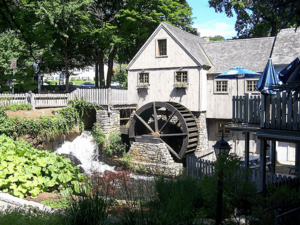Plimoth Grist Mill facts for kids
The Plimoth Grist Mill is a special kind of mill that grinds grain into flour. It's located in Plymouth, Massachusetts. This mill is a rebuilt version of the original Jenney Grist Mill. It stands in the exact same spot where the first mill was built a long time ago.
Contents
What is a Grist Mill?
A grist mill is like a big machine that uses large stones to crush grains. These grains can be things like corn, wheat, or rye. When the grains are crushed, they turn into flour or meal. People then use this flour to bake bread, make pancakes, or cook other foods. The Plimoth Grist Mill uses water power to turn its grinding stones.
A Look Back: The Mill's History
The story of the Plimoth Grist Mill is quite old! It goes back to the early days of America.
The First Mill: John Jenney's Dream
A man named John Jenney built the very first grist mill in Plymouth. He was a Pilgrim who came to America in 1623. John Jenney finished building his mill in 1636. After he passed away, his wife, Sarah, took over running the mill. Later, their son Samuel sold it. The mill changed hands a few more times over the years. Sadly, a big fire destroyed the building in the mid-1840s.
Rebuilding for the Future
After the fire, other types of mills were built on the property. These mills made different products, not just food. In the middle of the 1900s, the town of Plymouth decided to rebuild the old Jenney Grist Mill. They wanted to bring back a piece of history! The new mill was finished in 1969. Some parts, like the huge grinding stones, came from an old mill in Pennsylvania.
The Mill Today: A Working Museum
Today, the Plimoth Grist Mill is a busy and exciting place. It's a working mill and a fun spot for visitors.
How the Mill Works
The mill is open to the public for most of the year. It grinds different grains like corn, wheat, rye, and barley. However, only corn is ground using the main grinding stones. When you visit, you can watch the mill workers in action! They grind the grains and also explain how everything works. It's like a live history lesson.
What the Mill Produces
The main products made at the mill are cornmeal and grits. These products are sold to many businesses in the area. This helps support the idea of eating local foods that are not heavily processed. In 2017, the mill even hosted a special event for farmers and food producers from all over the state.
The River and Its Fish
The mill sits on a river called Town Brook. This brook is home to a special annual event each spring. Thousands of tiny fish called alewives swim up the brook to lay their eggs. It's an amazing sight! For many years, there weren't many alewives. But thanks to hard work, their numbers have grown a lot. In 2003, there were about 7,000 alewives. By 2016, there were almost 200,000!


